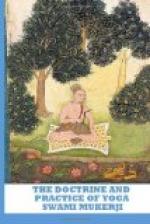The above exercises will wonderfully develop and strengthen anyone who tries them. The deep breathing exercise already given is known as Pranayama or Controlling the Psychic Breath. Its main purpose is to give you control over your Prana and unfold the Psychic Force latent in you. Practised on an impure body and weak lungs it may do harm. Hence students are advised to undergo the above 10 breathing exercises first and then, when their lungs have developed the power of endurance, they should take that up. It will take time, patience, and serious work. But if the student is sufficiently energetic he will perfect all these exercises in six months. But follow nature’s plan and be slow and steady.
DIET.
You all know that pure food brings pure blood. You should avoid the two extremes of gluttony and daily fasting and abstemiousness. You should know (1) What to eat (2) How to eat (3) When to eat.
Concentrated food such as contains the maximum amount of nourishment in a minimum quantity should be used. The student should study some reliable hand book on the relative values of food and use his judgment. We ourselves use nuts, milk, fruits, whole wheat bread, rice in very small quantity, pulse, etc. Those who are non-meat eaters—and we advise it strongly—will do well to see to it that their menu has a good supply of albuminous food, as vegetarians often run the risk of being overfed as to starch and underfed in nitrogenous foods.
(2) Chew and masticate properly so as to extract the food-Prana in full and break up the food-substance into very small bits, reducing it to pulp. Do not be in a hurry to bolt your food but let it linger in your mouth so as to be properly insalivated and so that the nerves of the tongue, cheek, etc., may all absorb energy from food. Remember your stomach is not lined with rows of teeth. This will give you double the nourishment you get ordinarily, avoid constipation, prevent malnutrition, non-assimilation and over-eating. Out of a very small quantity of food you can extract perfect nourishment and thus you avoid loading and “stuffing” the stomach with unnecessary food. It is also economical in case you are a thrifty soul! Eat to live. Don’t live to eat.
(3) Eat when you are hungry. That cultivated “appetite” that craves for satisfaction at certain stated intervals of the day and brings on an “all-gone” fainting, nauseating sensation in the stomach is not real “hunger.” In real hunger there is absolutely no sensation in the stomach but there is a rich and continuous flow of saliva in the mouth and that sort of thing makes you enjoy the plainest of fares. Even a dry crust of bread will taste sweet as Manna. Cut off your breakfasts. Drink cold water instead. Eat one good, nourishing meal at 12 A. M., and one light meal in the evening.




